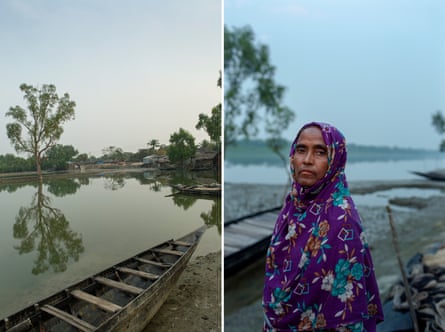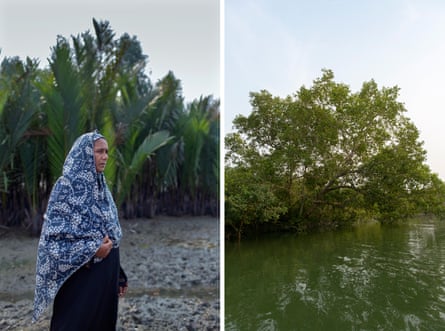Nobody saw exactly what happened in the minutes leading up to Aziz Murad’s death. But when his friends got back to the boat where they had left him, they found only his severed hand in the fishing net he was untying.
“We were only gone for about five minutes,” says Abu Sufyan, who was first to reach the boat. “When we got back, he was gone and there was blood everywhere.”
Conflict between people and wildlife is intensifying across the planet as habitat loss, growing populations and the climate crisis fuel competition for fertile, habitable land. In the Sundarbans, on the southern coast of Bangladesh, an estimated 300 people and 46 tigers have been killed in human-tiger conflict since 2000.

Bangladesh’s Sundarbans is the world’s largest contiguous mangrove forest. The Unesco world heritage site – a maze of islands, winding creeks and mudflats – is home to a huge variety of plants and animals. It is also a sanctuary for some of the world’s most endangered species, including the largest single population of Bengal tigers.
Over the next few decades, researchers predict that climate change and rising sea levels mean no suitable tiger habitat will be left in the Sundarbans by 2070. According to Bangladesh’s last census, 114 tigers are estimated to remain; down from 440 in 2004. The results of the latest census are expected in July.
But it is not only tigers that face an existential threat. More than 3.5 million people live on the edge of the Sundarbans, eking out an existence by fishing, collecting honey or wood, and subsistence farming. More than 40% of households are below the poverty line, but the climate emergency has made life here even harder.

As sea levels rise, islands disappear and increasing water salinity threatens the health of mangrove forests and the quality of soil and crops. Disruptions to fish populations also create disastrous consequences for communities.
As a result, desperate villagers are often left with little choice but to venture deeper into the forest, making them more vulnerable to tiger attacks. The intensive exploitation of the forest is also forcing tigers to leave the forest in search of food, targeting livestock and humans.
The Bangladesh government is constructing a 40-mile fence to keep tigers and people out of each other’s territories and has set up 49 tiger-response teams in an effort to lessen the conflict.
These groups of villagers are trained to scare tigers back into the forest, monitor local human-tiger conflicts and stop other local people killing tigers. The teams, with Bangladesh’s Forest Department, might release dozens of tigers back into the forest over a year, preventing harm to both animals and people.
But they could not save Aziz Murad. On a cool spring morning in Koyra, a coastal sub-district of Khulna, Murad’s widow, Shuna Banu, 43, sits in the shade of a banana tree and recounts how her life changed that fateful day.
“I remember receiving the phone call,” she says. “Though tiger attacks are common in this area, nothing prepared me for what would come next.”

The attack in 2020 did not just leave Banu without a husband; it turned her into an outcast overnight. In a superstitious society where being a “tiger widow” carries its own stigma, she was considered cursed and ultimately blamed for her husband’s death.
Banu joined hundreds of other women living in the Sundarbans region referred to as swami khejos – “husband eaters”.
“You won’t find a family here that hasn’t been affected,” says Maksudur Rahman, chief executive of the Bangladesh Environment and Development Society (Beds). “Villagers live in constant fear of death. In almost every neighbourhood, there are women whose husbands were killed by tigers.”
Banu’s in-laws decided she could no longer stay with them in case she brought bad luck, so she moved back in with her parents. In a rural area that relies on agriculture and fishing, she says tiger widows like her are prevented from undertaking traditional occupations.
after newsletter promotion
“Not only did I lose my husband, I lost my right to a dignified life,” she says. Confined to her parents’ small mud hut and unable to work, Banu fell further into poverty.
A few doors away lives Reshma Khatun, 38, whose husband was killed in a tiger attack four years ago. Abdul Gazi had been collecting honey from the Sundarbans for more than a decade. One evening, as he was getting ready to cook at a camp in the forest, a tiger pounced on him.
Since his death, Khatun has struggled to provide for their two boys. Tiger widows are meant to receive government compensation of 300,000 taka (£2,190) but in reality it is difficult to make a claim and the amount is not sufficient for families who have lost their sole breadwinner. Women widowed before the policy came into effect in 2011 are also ineligible.

Across the Kholpetua River, in an old rickety house on the edge of the forest, lives 60-year-old Jamiroon Bibi. Her husband was killed by a tiger during a fishing trip nearly two decades ago. In that time, she has watched countless other women become pariahs after losing their husbands to tiger attacks.
“People around here have always been superstitious. But why should we have to suffer because of some age-old folklore that makes witches out of widows – and pits us against one another?” she asks.
The aim of Beds is to create employment opportunities for vulnerable communities living around the Sundarbans, including tiger widows, while at the same time protecting the environment. “Our mission has always been to promote ecological balance and create harmony between humans and their environment,” says Rahman.
“Nature has always provided for those who have little,” he adds. “But the people here have nothing – so they over-harvest what they can, putting pressure on the entire ecosystem.”
To reduce dependence on forest resources, the non-profit organisation has helped set up two cooperatives employing local women, including tiger widows, who are taught how to harvest honey and plants responsibly to produce sustainable non-timber forest products, including juice, mango pickle and traditional handicrafts.
The women gather raw materials from communal areas rather than the forest and are involved in the entire process, from collection and processing to packaging and labelling.
“We also help them to market and sell the products at a fairer price,” says Rahman. The women earn about 25,000 taka a month, with the initiative helping more than 300 households so far.

Many tiger widows are now earning a living and regularly visit one another, sharing meals and taking turns to look after the children when one of them has to work.
“Society will always find ways to blame women,” says Bibi, looking out into the vastness of the Sundarbans beyond her small veranda. “Life here is difficult enough, we don’t need to burden ourselves any further.”
